Seaside vs. Rosemary Beach
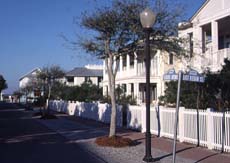
Seaside's Ruskin Street,
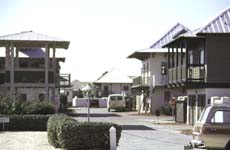
Rosemary Beach street
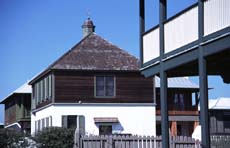
West Indian style at Rosemary Beach

West Indian style on Curaçao
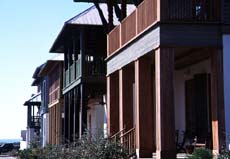
Porches at Rosemary Beach
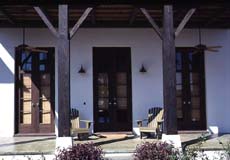
Porch at Rosemary Beach
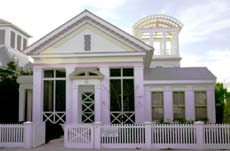
Truman House at Seaside
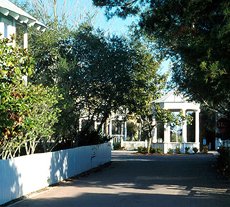
Seaside street
My host at Seaside described its sister development then under construction a few miles away, Rosemary Beach, as using earth tones to replace Seaside's pastels, but there is a more significant difference: the house forms chosen for Rosemary Beach are not so automatically familiar as those at Seaside. The planners set up the architectural code to encourage vernacular forms, but not mid-American vernacular.
About 45% percent of the lots at Rosemary Beach are slated to have what the salespeople (but not the architects) describe as West Indian style homes -- one is pictured here in comparison with a house from a real West Indian island (Curaçao). The remaining 55% percent of the houses are divided among less recognizable American archetypes. There are to be 15% of the houses that follow a general pattern taken from St. Augustine, Florida. The rest follow patterns from Charleston and New Orleans. (Many Seaside houses also are derived from Charleston forms, but with more variation.) At Rosemary Beach the houses tend towards cubical or rectangular solids with peaked or hipped roofs.
Porches at Rosemary Beach are smaller than at Seaside and are usually recessed into the house volume rather than added on to the main body of the house. There are no Georgian details or classical columns, and no towers. The effect is strikingly different than Seaside's instant recognizability. Besides being darker in color, the new development's houses seem lower and heavier, more rooted in the earth than Seaside's fanciful lines and towers. Seaside's house forms seem as light hearted as they are pastel colored, Everytown's dream. In contrast, Rosemary Beach's house forms are solid and serious.
The firm (Duany-Plater-Zyberk) who planned Seaside and spearheaded the New Urbanist movement also planned Rosemary Beach. Many of the spatial strategies are similar, though Rosemary Beach does not have a full version of Seaside's secondary circulation paths. Still, if Rosemary Beach had been built before Seaside I doubt it would have received the attention that Seaside's recognizability and fancy attracted. Nonetheless, Rosemary Beach shows that a New Urbanist development can earn premium prices without the instant recognizability of standard architectural styles -- at least if it is on a beach. The smallest lots farthest from the ocean at Rosemary Beach sell for fifteen times the original price of Seaside's most expensive lots, and you don't want to know the price of shorefront.